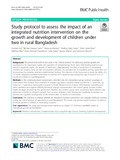| dc.contributor.author | Ara, Gulshan | |
| dc.contributor.author | Sanin, Kazi Istiaque | |
| dc.contributor.author | Khanam, Mansura | |
| dc.contributor.author | Sarker, Shafiqul Alam | |
| dc.contributor.author | Khan, Sihan Sadat | |
| dc.contributor.author | Rifat, Mahfuza | |
| dc.contributor.author | Chowdhury, Imran Ahmed | |
| dc.contributor.author | Askari, Sufia | |
| dc.contributor.author | Afsana, Kaosar | |
| dc.contributor.author | Ahmed, Tahmeed | |
| dc.date.accessioned | 2022-04-10T06:23:48Z | |
| dc.date.available | 2022-04-10T06:23:48Z | |
| dc.date.copyright | 2019 | |
| dc.date.issued | 2019-11-01 | |
| dc.identifier.citation | Ara, G., Sanin, K. I., Khanam, M., Sarker, S. A., Khan, S. S., Rifat, M., . . . Ahmed, T. (2019). Study protocol to assess the impact of an integrated nutrition intervention on the growth and development of children under two in rural Bangladesh. BMC Public Health, 19(1) doi:10.1186/s12889-019-7777-y | en_US |
| dc.identifier.uri | http://hdl.handle.net/10361/16526 | |
| dc.description | This article was published in BMC Public Health [ © The Author(s). 2019 Open Access This article is distributed under the terms of the Creative Commons Attribution 4.0 International License (http://creativecommons.org/licenses/by/4.0/)] and the definite version is available at: https://doi.org/10.1186/s12889-019-7777-y The Journal's website is at: https://bmcpublichealth.biomedcentral.com/articles/10.1186/s12889-019-7777-y#citeas | en_US |
| dc.description.abstract | Background: The period from birth to two years is the “critical window” for achieving optimal growth and
development. An inadequate quality and quantities of complementary foods, poor child-feeding practices and
infection negatively impact the growth of under-twos. Approximately one-third of under-fives in developing
countries are stunted; many are also micronutrient deficient. An estimated 6% of mortalities among under-fives can
be prevented by ensuring optimal complementary feeding. The objective of the study was to assess the ability of a
12-month integrated nutrition intervention to improve the nutritional status (length-for-age Z-score) of 6 to 12-
month-old children in rural Bangladesh.
Methods: In this community-based randomized controlled trial, the intervention group received a package of
interventions that includes, food vouchers; to prepare egg-based nutritious snacks (suji firni for < 1-year-olds, suji
halwa for > 1-year-olds), micronutrient powder to fortify children’s food at home, child feeding counselling and
water, sanitation and hygiene (WASH), behaviour change communication. The control group received routine
health messages provided by the government. Baseline and endline surveys were conducted; Data collection was
performed monthly on children’s growth, food voucher utilization, child feeding and morbidity. In addition, we
assessed the cognitive development of the children after 12 months of intervention.
Conclusion: This trial aims to explore whether an integrated nutrition intervention can mitigate childhood stunting
during the critical window of opportunity in rural Bangladesh. The results may provide robust evidence to improve
the linear growth of children in developing countries. | en_US |
| dc.language.iso | en_US | en_US |
| dc.publisher | BMC | en_US |
| dc.relation.uri | https://bmcpublichealth.biomedcentral.com/articles/10.1186/s12889-019-7777-y#citeas | |
| dc.subject | Nutrition | en_US |
| dc.subject | Intervention | en_US |
| dc.subject | Complementary food | en_US |
| dc.subject | Length-for-age Z-score | en_US |
| dc.subject | Stunting | en_US |
| dc.subject | Cognitive development | en_US |
| dc.title | Study protocol to assess the impact of an integrated nutrition intervention on the growth and development of children under two in rural Bangladesh | en_US |
| dc.type | Journal Article | en_US |
| dc.description.version | Published | |
| dc.contributor.department | Brac James P. Grant School of Public Health | |
| dc.identifier.doi | https://doi.org/10.1186/s12889-019-7777-y | |
| dc.relation.journal | BMC Public Health | |

